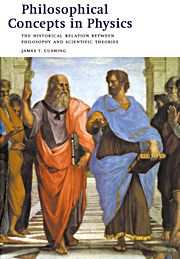 Philosophical Concepts in Physics
Philosophical Concepts in Physics Book contents
- Frontmatter
- Contents
- Preface
- Copyright acknowledgments
- PART I The scientific enterprise
- PART II Ancient and modern models of the universe
- 4 Observational astronomy and the Ptolemaic model
- 5 The Copernican model and Kepler's laws
- 6 Galileo on motion
- PART III The Newtonian universe
- PART IV A perspective
- PART V Mechanical versus electrodynamical world views
- PART VI The theory of relativity
- PART VII The quantum world and the completeness of quantum mechanics
- PART VIII Some philosophical lessons from quantum mechanics
- PART IX A retrospective
- Notes
- General references
- Bibliography
- Author index
- Subject index
5 - The Copernican model and Kepler's laws
Published online by Cambridge University Press: 05 June 2012
- Frontmatter
- Contents
- Preface
- Copyright acknowledgments
- PART I The scientific enterprise
- PART II Ancient and modern models of the universe
- 4 Observational astronomy and the Ptolemaic model
- 5 The Copernican model and Kepler's laws
- 6 Galileo on motion
- PART III The Newtonian universe
- PART IV A perspective
- PART V Mechanical versus electrodynamical world views
- PART VI The theory of relativity
- PART VII The quantum world and the completeness of quantum mechanics
- PART VIII Some philosophical lessons from quantum mechanics
- PART IX A retrospective
- Notes
- General references
- Bibliography
- Author index
- Subject index
Summary
The form of the Ptolemaic system, as depicted in Figure 4.7, was in accord with the general thinking of the day, fit past observational data and predicted fairly well the future positions of the then-known planets. In his De Revolutionibus, published at his death in 1543, and in his earlier Commentariolus (Sketch of the Hypotheses for the Heavenly Motions), about 1514, Nicolaus Copernicus seriously attacked the Ptolemaic model. He did this largely because he felt that some of the devices (in particular, the equant) used to compound circular motions in Ptolemy's system produced motions that were not uniform enough.
[I]n setting up the solar and lunar movements and those of the other five wandering stars, [mathematicians] do not [all] employ the same principles, assumptions, or demonstrations for the revolutions and apparent movements. For some make use of homocentric circles only, others of eccentric circles and epicycles, by means of which however they do not fully attain what they seek.… But even if those who have thought up eccentric circles seem to have been able for the most part to compute the apparent movements numerically by those means, they have in the meanwhile admitted a great deal which seems to contradict the first principles of regularity of movement.
Yet the planetary theories of Ptolemy and most other astronomers, although consistent with the numerical data, seemed likewise to present no small difficulty.
Information
- Type
- Chapter
- Information
- Philosophical Concepts in PhysicsThe Historical Relation between Philosophy and Scientific Theories, pp. 59 - 73Publisher: Cambridge University PressPrint publication year: 1998